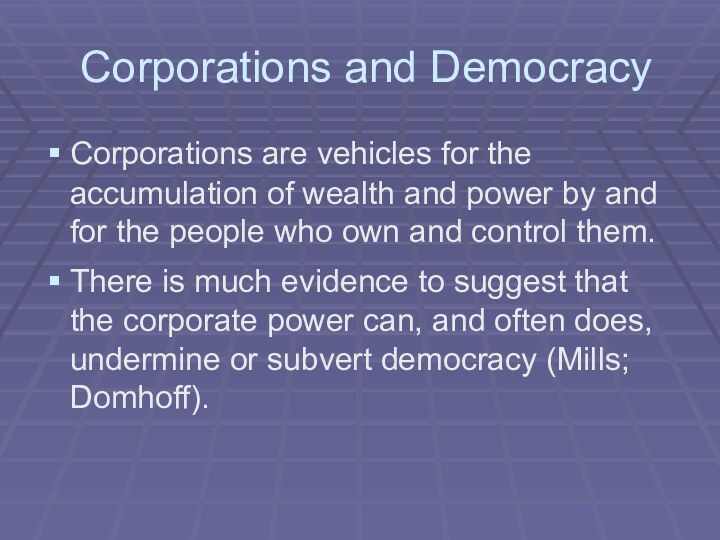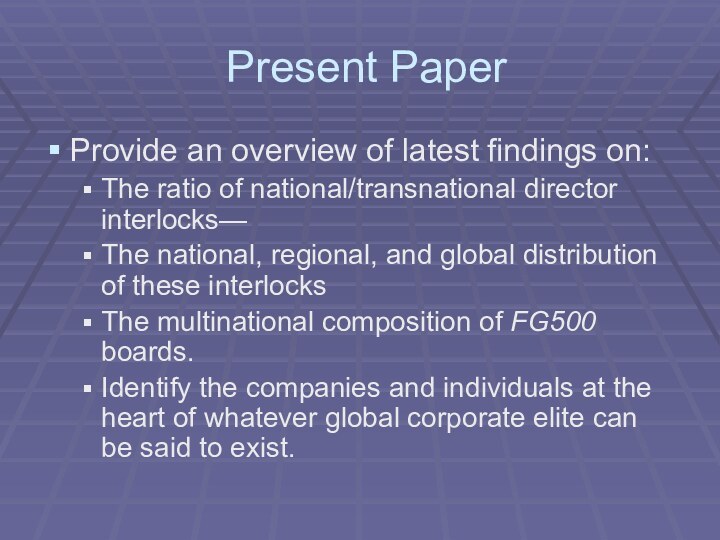Слайд 2
Globalization and TNCs
Debates continue about globalization, but virtually
everyone agrees that transnational corporations (TNCs) are central to
the process.
The sociological study of TNCs is therefore critical to any understanding of contemporary globalization.
Слайд 3
Corporations and Democracy
Corporations are vehicles for the accumulation
of wealth and power by and for the people
who own and control them.
There is much evidence to suggest that the corporate power can, and often does, undermine or subvert democracy (Mills; Domhoff).
Слайд 4
Global Elite and Democracy I
The possible emergence of
a transnational elite raises important questions about the efficacy
of global democracy in the face of transnational corporate power.
The decisions made by this elite group of manager/capitalists can have life or death consequences for billions of workers, consumers and citizens, and yet the people who run these TNCs are largely unaccountable to the world’s people.
Слайд 5
Global Elite and Democracy II
To the extent that
TNCs are:
able to escape or avoid what democratic
control can be brought to bear on them via the laws and policies of nation-states, and/or
in the absence of transnational institutions capable of enforcing democratic will
the people of the world will be left have to defend themselves against an increasingly wealthy, powerful, and sometimes heavily armed, global ruling class (Robinson, Sklair, Van Appledoorn, Faux).
Слайд 6
An Emergent Global Elite?
The specter of a global
ruling class haunts global democrats, so it is critical
to determine if our fears are justified through empirical research on TNCs and the people who own and control them.
At present it is very much and open question whether any transnational, let alone truly global, ruling class exists or is in the process of forming.
Слайд 7
Purpose of Research Program
Gather data needed to evaluate
the claim that transnational corporate/capitalist classes exist or are
forming, and
Identify the global corporate elite that would likely be involved in leading the formation of any such transnational capitalist class.
Слайд 8
Data
Previously I used the UNCTAD list of the
top 100 non-financial and top 50 financial transnational corporations.
In
my current research I use the corporations that comprise the Fortune Global 500 for 2006 (FG500).
Слайд 9
Research on the Global Elite
The corporate community has
been a central focus in studies of national elites
(Mills, Domhoff)
Corporate interlocks and the multinational composition of corporate boards have been used to search for evidence of a global corporate/capitalist class (Fennema, Carroll, Kentor, Nollert, Staples, Van Veen).
Слайд 10
Assumptions
I do not assume that top corporate executives
do or would constitute the entire global elite.
I only assume that if a global corporate/capitalist elite is emerging, or ever does emerge, the executives who run the world’s largest TNCs are or will be important to it.
Слайд 11
Assumptions
The directors and corporations that are more connected
to or integral to the network are more powerful
within the corporate community
The connections created among corporations and directors contribute to class solidarity and cohesion.
Слайд 12
Present Paper
Provide an overview of latest findings on:
The
ratio of national/transnational director interlocks—
The national, regional, and global
distribution of these interlocks
The multinational composition of FG500 boards.
Identify the companies and individuals at the heart of whatever global corporate elite can be said to exist.
Слайд 13
Findings: The FG500
The FG500 companies and directors are
concentrated in the “triad” of Europe, the Americas, and
Australasia, with the United States, Japan, Britain, France, and Germany together accounting for 70% of the companies on the GF500.
These corporations and the directors who run them are headquartered in or are citizens of only 42 of the world’s 190+ nations.
Control over the world’s largest economic assets is concentrated in the hands of a relatively few nations, nationalities, and companies.
Слайд 14
Findings: Interlocks
Of the 6,632 director names, 5,095 appear
only once, meaning that these individuals serve on only
one board within the FG500.
The remaining 1,537 directors, or director positions, are occupied by 659 individuals, and together these individuals create 1,201 Company A to Company B links, or interlocks.
The 659 linkers come from an even more select group of nations, with only 21 nations accounting for all 659 linkers, and the United States alone accounting for 47% of the total.
Слайд 15
Findings: Transnational Links
Of these 1,201 company A to
company B links, 319, or 26.6%, connect companies headquartered
in different countries.
Most (95%) of the linked companies are concentrated in either Europe or the Americas.
European companies are more than twice as likely (36.8% versus 15.6%) to be involved in transnational linkages than companies headquartered in the Americas.
Слайд 16
Findings: The U.S.
The United States has the largest
number of companies in the GF500 (170), the largest
number of directors (2,070), the largest number of linkers (310), the largest number of female linkers (57), and the largest number of linked companies (994)
Yet, the United States ranks quite low in its proportion of linked companies involved in transnational links (130/992), at 13.1%. Only India, with at 6.7%, and Japan at 12.7% rank lower than the U.S.
Слайд 17
Findings: Companies
Most of the companies (370/498 or 74.3%)
are connected to each other and so part of
the network.
But only 219 corporations are involved in transnational interlocks.
Слайд 18
Findings: Europe
Most (89.1%) of the GF500 transnational links
occur within Europe or involve European companies.
Слайд 19
World Distribution of Corporate Interlocks
Слайд 20
Findings: Board Globalization I
Of the 6,632 directors, we
find that 754, or 11.4%, were “foreigners” on the
boards on which they served.
Example: Harald Arnkvaern, a Norwegian, was found to serve on the board of the Swedish firm, Nordea Bank
Example: Kevin M. Murai, from Canada, serves on the board of Ingram Micro, headquartered in the United States.
Because of board interlocks one individual might create both “foreign” and “non-foreign” connections.
Example: Francis Mayer serves on three boards within the FG500, two French (Groupe Caisse d'Épargne; Veolia Environment), and one Belgian (Dexia Group). Only his board membership on Dexia counts as a “foreign” board membership.
Слайд 21
Findings: Board Globalization II
50.6% of the FG500 have
at least one “foreigner,” on board.
The number of different
nationalities represented on the board ranges from 1 to 8, with an average of 2.06.
Multinational corporate boards are highly concentrated within Europe.
Слайд 22
Findings: Globalized Boards in Europe
Слайд 23
Summary
The findings are consistent with previous research showing
relatively low levels of transnational interlocking and board globalization
worldwide.
To the extent that transnational interlocks and board globalization are occurring, they are occurring in Europe.
No matter which way one looks at the findings, European countries, companies, and directors seem to be most heavily involved in whatever corporate globalization is occurring within the GF500.
Слайд 24
The Global Power Elite
There are 48 individuals (of
the 659 linkers) who are involved in both national
and transnational interlocks.
70.8% are from Europe and 29.2% are from the Americas.
Слайд 26
Who They Are
These are some of the most
well-known names in global business, particularly European business.
Many
of these individuals are regularly listed among the world’s wealthiest people, routinely serve in high government posts, and can usually be found each January at the swankiest parties in Davos.
Слайд 28
The Top Corporations
There are 30 companies that rank
within the top 50 in both national and transnational
interlocks.
Most of these companies are household names and all but a few US companies are headquartered in Europe.
All 30 companies can be found on the list of companies that connect the top 48 most-connected directors.
Thus, to the extent that a Transnational Corporate/Capitalist Class—or at least the elite fraction of that class—can be said to exist, its core is to be found in these individuals and companies.
Слайд 29
Summary and Conclusions I
We have understood for
a long time that corporate power hobbles democracy. But
we also know that nominally democratic governments have, at times, provided a significant level of resistance against corporate power run amok.
Thus, the possible emergence of transnational corporate power—power in the form of a corporate elite acting on behalf of a transnationalizing capitalist class—is worrying to those of us interested in conserving and expanding democratic alternatives to corporate power.
Слайд 30
Summary and Conclusions II
To this point my efforts
have been devoted to answering some basic questions about
who might be involved in a transnational corporate elite, how this elite relates to the class it represents, and how it acts in relation to the class it seeks to dominate.
Thus far the results suggest that the level of global corporate elite integration is relatively low—at least when measured by corporate interlocks and board globalization—but that it does exist and so is certainly worth monitoring.
At the same time, the research also suggests whatever transnational corporate elite formation is occurring is highly concentrated among European countries, corporations, and individuals. Indeed, to this point what we seem to be studying is not a transnational corporate elite, but largely a European transnational elite. Global corporate elite formation might be better thought of as economic regionalization, and European-ization in particular.
Слайд 31
Summary and Conclusions III
As has been suggested, monitoring
and studying the European corporate elite—perhaps beginning with the
or 50 individuals and 30 or so corporations identified in the present research—is important because we can see how these people relate to each other, to the broader capitalist class whose interests they are presumably advancing, but also how they behave toward both European states and to the European working-class—the class that has most to lose as a result of an increase in trans-European corporate power and a consequent decline in European democracy. There is much work to be done by those scholars specifically interested in global corporate power in Europe.
While it’s evident that most of the “transnational action,” is currently centered in Europe, we should not confine our focus exclusively to Europe.































